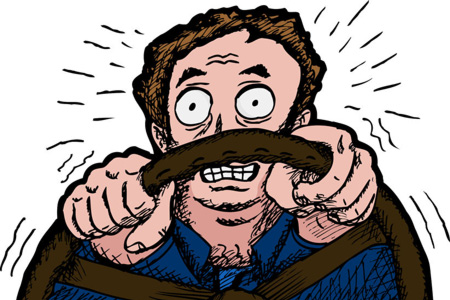Having a panic attack is never a pleasant experience and can result in a rapid heart rate, shallow breathing, high blood pressure, headaches, feelings of anxiety, depression and chest pain. At the best of times this is highly frustrating and upsetting but what’s worse is that it can potentially put you in danger – especially if you happen to be doing something that requires your full focus and attention.

Take driving for instance. If you’re on the motorway then you might easily be doing 60-70mph and at all times you need to have complete focus on the road ahead. If you start hyperventilating and feeling dizzy, then this has the potential to be dangerous.
But that’s where the bigger problem comes in – the more you worry about the danger of having a panic attack as you drive, the more worked up you’ll become and the more likely you’ll actually be to have a panic attack with all the symptoms.
Read on then and we’ll look at why panic attacks are common and what you can do to prevent and treat them.
Why Do You Get Panic Attacks While Driving?
Panic attacks are relatively common for those who suffer with anxiety about driving. Driving a car doesn’t always have to be a stressful experience but it certainly can be if you’re not terribly confident on the roads.
When you drive, you need to be highly focused on the traffic and the surroundings around you and you will have to react to other cars and hazards coming towards you. The fear of things coming towards you suddenly is actually the one ‘universal’ human fear that causes an increased heart rate in almost everyone. Driving is essentially a scenario where you have countless things coming towards you at great speed. Throw in visibility problems and perhaps even a nagging back-seat driver and you have a pressure cooker of a stressful situation. The fact that you will often be in a hot space and perhaps feeling somewhat claustrophobic and/or uncomfortable also doesn’t help.
Driving anxiety might be worse too if you have been in an accident or even if you know of someone who has been recently. Likewise, if you’re new to driving or if you haven’t driven for a long time, you may also find that the symptoms of anxiety are more likely to rear their ugly heads.
Only in some cases though will ‘driving anxiety’ develop into a full panic attack. At this point, your nerves and focus cause your body to engage you ‘fight or flight’ response. This is characterized by the release of adrenaline, dopamine and other neurochemicals and hormones that make you more alert and switched on while also causing the physiological effects we associate with stress.
This in itself can be a scary and unpleasant experience though and if you then start panicking that you’re struggling to stay calm while driving, you can actually work yourself up and thereby exacerbate the very symptoms you’re trying to avoid. Your heart rate increases, you breathe faster and faster and eventually you start feeling light headed – at which point it’s potentially dangerous.
How to Deal With Panic Attacks
While it can be dangerous in theory, in most cases there is actually nothing to worry about. This is because panic attacks do not strike suddenly but instead telegraph their arrival long in advance so you have time to prepare.
In other words, if you notice the symptoms of a panic attack as you drive, you can simply find somewhere to pull over and calm down. This means that there is really nothing to be afraid of while you’re driving and knowing this in itself is one of the best ways to prevent the problem from getting worse.
Remember: panic attacks happen when you continue to work yourself up and get more anxious. If you are able to instead ‘rise above’ the attack and distance yourself from what’s happening, then you should find that the symptoms are far more likely to subside on their own.
Knowing this, there may not be a desperate need to pull over at all then, as long as you can keep yourself calm. Try breathing deeply and slowly in order to combat hyperventilation and pull over into the slow lane where things are a little calmer. Remind yourself that in this situation the only thing to fear is fear itself – quite literally!
If you find you are regularly suffering from panic attacks then you should take measures to try and prevent them. This means addressing two aspects: the anxiety you get when driving and the panic attacks themselves. To approach the former you should practice more driving, look into getting additional lessons (such as a ‘pass plus’ course) and you should do everything you can to make driving less stressful (ensuring maximum visibility, driving a car you’re happy in etc.). For the latter, you should look at getting therapy to help you overcome your panic attacks. Particularly effective is cognitive behavioral therapy which will give you a series of psychological tools you can use to prevent anxiety attacks while driving and to improve anxiety in general throughout your life.



